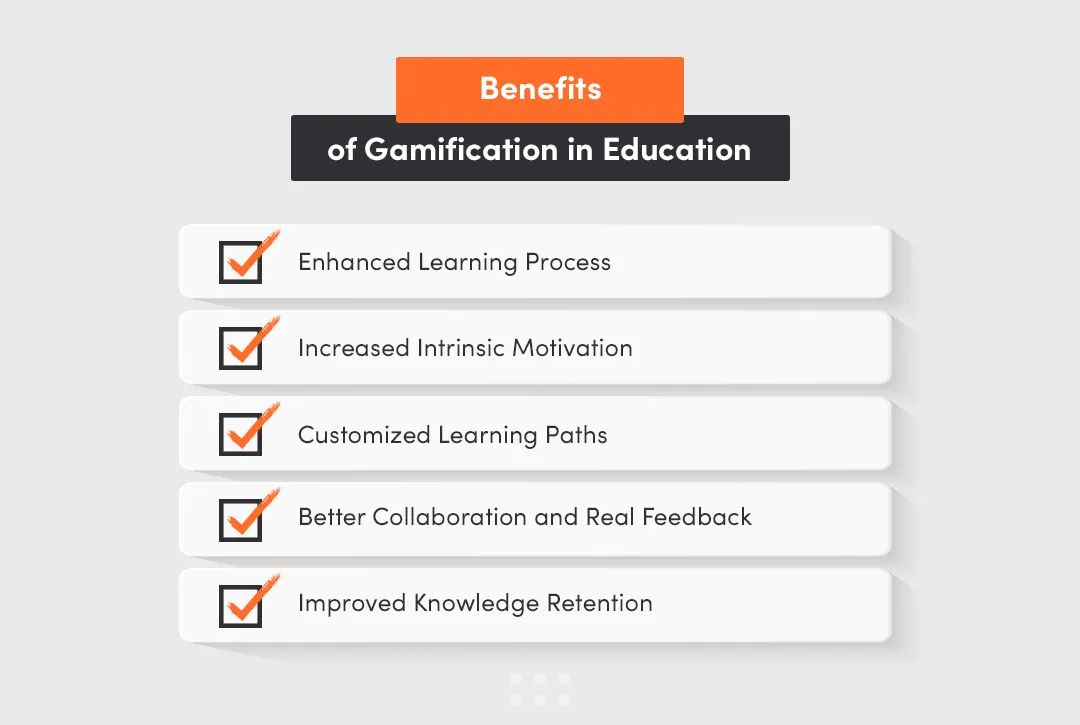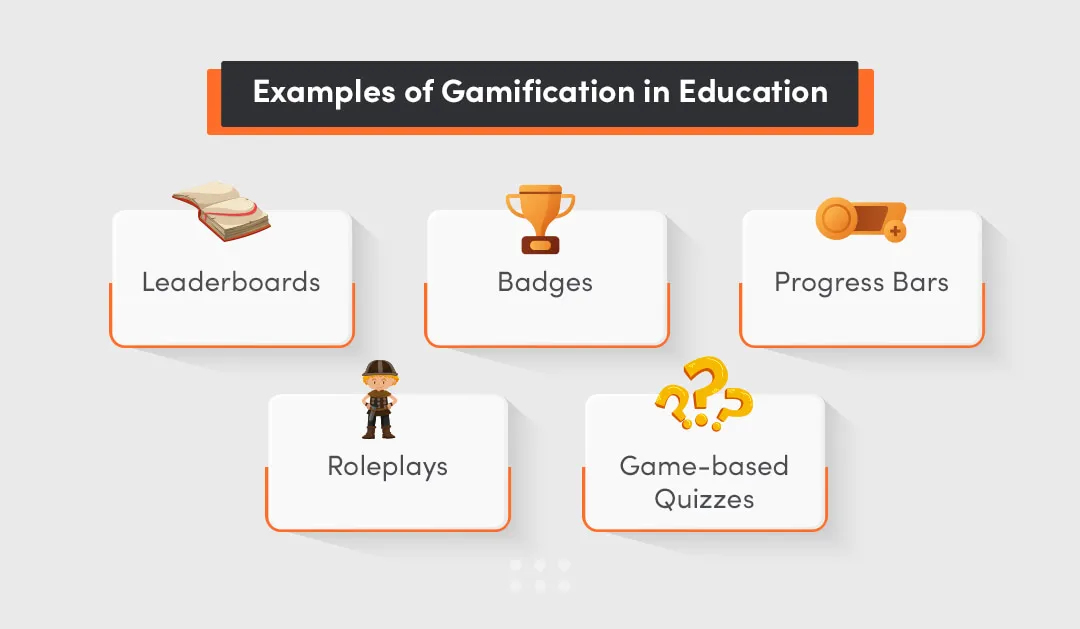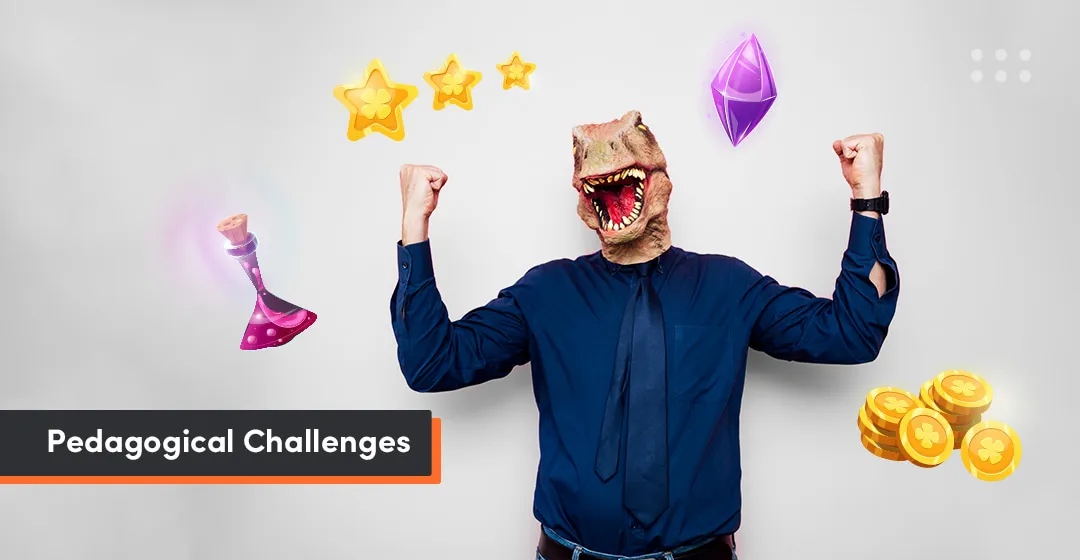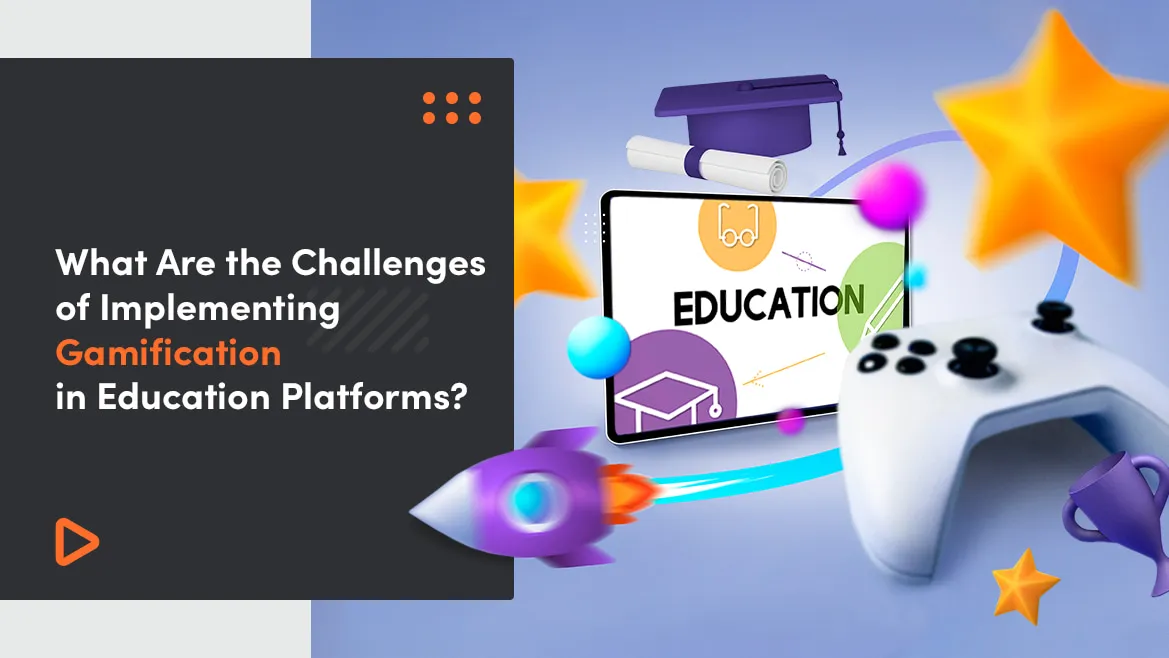Did you know that 90% of employees say gamification makes them more productive?
The term "gamification" in education refers to adding game elements to educational platforms, such as interactive challenges, leaderboards, points, and badges, to improve the online learning journey.
Studies have shown that gamification greatly improves student motivation and performance. The study further says that users are more productive (over 48% higher) and the platform has higher sales growth when implementing gamification features like leaderboards or badges (The Tech Report).
But… As with every innovation, there come challenges!
Gamification may present a few problems when integrated into educational platforms.
In this article you will learn:
- What are the benefits of Gamification elements in the EdTech industry?
- Best examples of game elements integrated with EdTech SaaS product
- What are the challenges in implementing game elements in an EdTech SaaS product?
- What are the technical challenges in gamification strategies?
- What are the challenges faced in gamification strategy for user experience?
- What are the administrative challenges in gamification strategy?
- How to implement game elements in your EdTech SaaS platform?
- A case study of Datagame and how they incorporated game mechanics in their SaaS platform to enhance their process and make learning fun.
-
Gamification enhances user motivation, engagement, and retention in EdTech SaaS platforms.
-
Key gamification elements include points, badges, leaderboards, challenges, and rewards.
-
Implementation time varies from 3 weeks to a few months, depending on feature complexity and project scope.
-
Customizing learning paths through gamification increases student achievement.
-
Game mechanics in an EdTech SaaS platform encourage better collaboration and provide instant feedback.
-
Effective gamification requires a user-friendly interface and thorough testing.
-
Technical challenges include infrastructure updates, data privacy, and security.
-
User experience challenges involve maintaining engagement and ensuring accessibility.
-
Pedagogical challenges include balancing rewards with educational value.
-
Administrative challenges include training educators and measuring success.
-
Datagame and Code.org effectively use gamification to enhance learning experiences.
Benefits of Gamification in Education
There are several benefits to implementing gamification elements/features to EdTech SaaS platforms. They can help enhance students' learning experiences and grow the EdTech businesses that either have their own LMS or offer SaaS white-label products. The following are the top 5 gamification advantages that everyone should know about:

Enhanced Learning Process
When game elements are included in the teaching process, an informal, engaging, and powerful learning environment is created. This greatly improves both engagement and knowledge retention.
A learner's experience will be richer and more productive when they are excited about their educational journey and are more likely to retain and recall the knowledge.
For instance, gamified features like streaks and awards are used by websites like Duolingo to make language learning enjoyable and successful.
Increased Intrinsic Motivation
Educators can use gamification features to appeal to students' natural competitiveness and intrinsic motivation, resulting in an engaging and fun learning process. Intrinsic motivation has a three times greater impact on staff engagement than extrinsic motivation which relies on incentives or rewards like money, fame, or recognition to motivate employees.
Gamification makes the learning experience interactive through competitive challenges and roleplaying. This engages students and helps them remember the material better by providing excitement from achieving goals and overcoming obstacles.
For example, Classcraft creates a story-driven learning experience by including roleplaying aspects so that learning has a lasting effect on students' passion and motivation to study.
Customized Learning Paths
Gamification makes learning more individual by letting students select their challenges and advance at their own speed.
According to research conducted by RAND Corporation on 11,000 students at 62 schools, students' achievement increased significantly the longer they were exposed to "personalized learning practices."
One of the main educational gamification benefits is this customized approach. It makes education more inclusive and adaptable for all parties involved by considering various learning styles and maximizing engagement and efficacy.
Gamified progress monitoring is used by platforms such as Khan Academy to assist students in navigating learning routes that are customized to their interests and skills, resulting in a more engaging and rewarding educational experience.
Better Collaboration and Real Feedback
EdTech companies that develop their own LMS or supply SaaS white-label products are uniquely positioned to improve teamwork and give immediate feedback.
Platforms like these facilitate a collaborative environment by including gamified components.
These components allow students to engage with instructors and peers more improving communication, making it also possible to provide helpful feedback on assignments and advancement on the go.
Real-time feedback tools, such as performance analytics and automated quizzes, let students immediately identify their areas of strength and growth, making their education more individualized and productive. These characteristics, for example, have been used e.g. in Moodle.
Improved Knowledge Retention
Gamification is a technique used by EdTech platforms like Quizlet to make learning more enjoyable, and it has been found to increase knowledge retention.
Gamification guarantees that students retain the material more successfully and encourages them to keep studying, which improves long-term educational achievements.
Examples of Gamification in Education
An effective gamification system relies on key gaming elements to motivate and engage participants. In this section, we will explore various examples of gamified learning that can enhance and improve your training programs:

Leaderboards
Leaderboards are integrated into the LMS platform to foster a competitive environment. This feature allows tracking of user performance and displaying top achievers, encouraging consistent engagement and motivation. It brings a dynamic element to the platform, pushing users to excel through healthy competition.
Badges
Badges serve as digital rewards for achieving specific milestones within the LMS. This feature acknowledges accomplishments and provides visual recognition of progress and expertise. The platform enhances user satisfaction by incorporating badges and promotes continuous skill development.
Progress Bars
Progress bars provide a visual representation of user advancement through courses and modules. This feature aids in maintaining transparency regarding learning progression and motivates users to complete tasks. It enhances user experience by offering clear, real-time feedback on their journey.
Roleplays
Roleplays simulate real-world scenarios within the LMS, allowing users to practice and apply their knowledge in a controlled environment. This feature enhances the learning experience by promoting active participation and critical thinking. It also enables users to gain practical skills directly applicable to their professional roles.
Game-based Quizzes
Game-based quizzes transform traditional assessments into interactive challenges. This feature enhances engagement and retention by making learning enjoyable and stimulating. It promotes active recall and application of knowledge, ensuring users stay invested and motivated throughout their learning process.
Try our developers.
Free for 2 weeks.
No risk. Just results. Get a feel for our process, speed, and quality — work with our developers for a trial sprint and see why global companies choose Selleo.
Challenges in Implementing Gamification in Online Education Platforms
Although gamification can significantly enhance learning experiences, this approach has several drawbacks. These difficulties include instructional and administrative obstacles as well as technical and user experience problems. It is important to comprehend and tackle these obstacles to effectively implement gamification in learning settings.
Technical Challenges
A lot of technical work might be involved in incorporating gamification examples into currently used educational systems.
The deployment of gamified features needs a strong infrastructure to manage higher processing loads and data traffic. Data security and privacy are especially important issues.
Talon.One claims that overcoming these technological obstacles necessitates careful design, investment in technology, and continual maintenance.
Integration Issues
Incorporating gamification elements into currently used educational systems might involve a lot of technical work. For instance, significant infrastructure changes or even a total rebuild are frequently necessary to add gamified features to Learning Management Systems (LMS) like Moodle or Blackboard.
Infrastructure Requirements
Robust infrastructure is required to deploy gamified features and manage higher processing loads and data traffic. For instance, many backend infrastructures are needed to guarantee that websites like Duolingo can accommodate millions of people participating in gamified learning activities in real time.
Data Privacy and Security
Data security and privacy are major issues as gamification requires gathering and analyzing private student information.
It is crucial to ensure that data protection laws, such as the GDPR, are followed and that possible breaches are prevented.
Platforms such as Classcraft need to secure user data with utmost care to preserve trust and compliance.
User Experience Challenges
A key gamification component is the user experience, but several obstacles can prevent it from working well. Accessibility and inclusivity are also important issues. To ensure that all the obstacles are tackled well, you must have knowledge and a complete understanding of these challenges.
Lack of Student Engagement
One significant issue is the potential lack of student engagement. If the gamified elements are not well-designed or do not align with students' interests, they may fail to capture and retain attention. For example, students may quickly lose interest if a gamified quiz lacks interactive and appealing features.
Accessibility and Inclusivity
Since not every student has equal access to technology or reacts to gamified components similarly, accessibility and inclusivity are also important issues. It is crucial to ensure that all students, including those with impairments, can utilize the gamified elements. Websites like Khan Academy must ensure that every user is considered while designing their gamified components.
Pedagogical Challenges

Pedagogical challenges in gamification within EdTech refer to the difficulties and obstacles educators and developers face when integrating game-based learning elements into educational technology. These challenges can include:
Overemphasizing Rewards and Punishments
A major pedagogical problem is balancing gamification's entertainment appeal and teaching benefits. Overemphasizing rewards can cause extrinsic motivation in students, who are more concerned with getting points or staying out of trouble than mastering the subject.
Ensuring Educational Value
Ensuring that gamified components support significant learning objectives without taking center stage over the instructional material is crucial. Websites like Quizlet must ensure that their game-based learning tests are educational and entertaining.
Balancing Fun and Learning Outcomes
Balancing enjoyment and learning objectives can be challenging, as placing too much focus on game features might distract from the learning objectives. For instance, instructional games on Prodigy-like platforms must carefully balance academic requirements and entertainment value.
Accessibility
Students shouldn't be overtaken by intricate game mechanics when learning gamification. It is imperative that gamified elements on sites such as BrainPOP, which target younger audiences, remain user-friendly and simple.
Administrative Challenges
In the context of Edtech, administrative challenges for gamification refer to the obstacles and difficulties that administrators and educators face when implementing gamified learning strategies. These challenges can impact the effectiveness and efficiency of integrating gamification into educational environments.
Key administrative challenges in Edtech gamification include:
Training Educators and Staff
It takes a lot of time and resources to ensure that staff members and teachers are competent in using gamified tools and incorporating them into their lesson plans. A successful deployment depends on teaching educators how to utilize these tools effectively.
Measuring Success and Impact
Creating trustworthy metrics to evaluate how well gamification affects learning objectives is essential for improving tactics and providing benefits. Platforms such as Edmodo need robust assessment methods to gauge the effectiveness of their gamified components.
Assessment Tools
To ensure continual improvement, it's important to develop tools that measure the impact of gamified components on student performance. For example, integrating comprehensive evaluation tools into Schoology's gamified modules can help effectively monitor students' progress.
Data Analysis
Strong data analytics skills are required because gathering and analyzing data to improve gamification methods can be difficult and time-consuming. Platforms like Canvas must invest in sophisticated data analytics to comprehend user behavior and enhance their gamification features.
Case Study Datagame
Datagame utilizes a range of gamification elements to create an engaging and effective learning platform. Leaderboards rank participants based on performance, fostering a competitive environment that motivates users to improve their skills and climb the ranks.
- link to portfolio: Datagame platform with gamified
Badges are awarded for achieving specific milestones and completing challenges, providing recognition and a sense of accomplishment. Progress bars clearly represent advancement, encouraging users to complete tasks and reach their goals with immediate feedback.
Additionally, Datagame incorporates roleplays to simulate real-world scenarios, allowing users to apply their knowledge in practical contexts. This hands-on experience promotes critical thinking and makes learning more immersive and relevant.
Game-based quizzes turn traditional assessments into interactive challenges, keeping participants engaged and motivated through fun and competitive elements like points and timed challenges.
How to Implement Gamification in Your SaaS Product
The major steps to implement Gamification in an EdTech SaaS platform involve establishing goals and objectives. This might entail strengthening consumer loyalty, improving learning results, or raising user engagement.
Determine which game mechanics align with your goals!!!
Points, badges, leaderboards, challenges, and prizes are typical components. Your infrastructure may need to be updated, and technical modifications may be necessary to accommodate the new features. A well-designed interface may greatly improve user engagement and experience.
Evaluation and testing should be done to find problems and obtain user input. Based on this input, the gamification features should be modified and enhanced as needed. To gauge progress and analyze areas needing improvement, keep a close eye on how the gamified aspects are doing and examine user data.
The Time Frame for Implementation

Gamification can be implemented in a SaaS product over various timeframes. Usually, it takes 3 weeks or a few months depending on how complex the features are, the project's scope, and the available resources. A methodical strategy that begins with fundamental gamification components and progressively adds more sophisticated features can help manage the process efficiently.
Example of Gamification in Kids EdTech SaaS Product
Code.org is an excellent example of using gamification to teach coding to kids. The platform incorporates various gamified interactive elements to make learning coding fun and engaging for young learners.
Games and Features on Code.org:
Hour of Code: This feature offers a selection of quick, entertaining coding lessons based on well-known video games and films, such as Star Wars and Minecraft. These online courses aim to provide fundamental coding ideas engagingly and interactively.
Progress Tracking: Learners can track their progress through coding activities on Code.org using levels and progress bars. This graphic depiction of development encourages students to keep studying and accomplish new goals.
Interactive Challenges: Students can resolve puzzles and make projects by participating in the platform's coding challenges. The learning process is lively and encouraging because these challenges frequently come with instant feedback and pointers.
Certificates and Badges: Students receive certificates and badges after finishing specific online courses or levels. These incentives promote further learning experiences while also acknowledging their accomplishments.
Code.org successfully engages young learners by introducing these gamified components, which make the learning experience enjoyable and instructive.
Summary
With gamification, you can enhance learner engagement, raise intrinsic motivation, and improve information retention in all types of EdTech SaaS products. However, you need to be aware of difficulties in the administrative, pedagogical, technological, and user experience sectors.
But if you prepare and plan carefully all necessary steps for the successful implementation of gamification elements, you will be able to avoid these difficulties.
Educational platforms may successfully leverage the potential of gamification to create more engaging and productive learning experiences by proactively addressing the above-mentioned areas.





